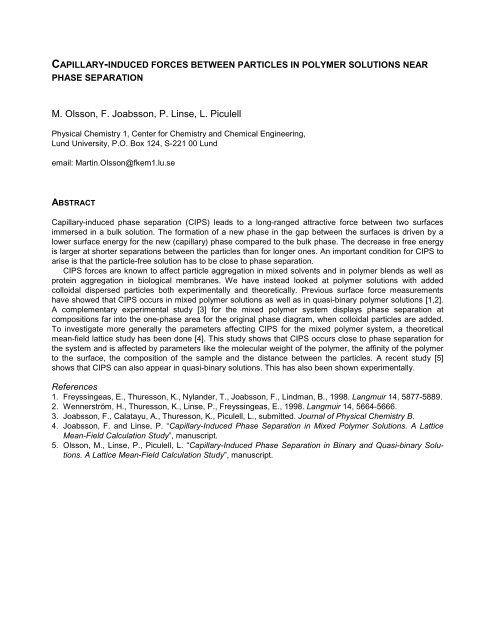Collapse of polymer brushes grafted onto planar ... - Wageningen UR
Collapse of polymer brushes grafted onto planar ... - Wageningen UR
Collapse of polymer brushes grafted onto planar ... - Wageningen UR
Create successful ePaper yourself
Turn your PDF publications into a flip-book with our unique Google optimized e-Paper software.
CAPILLARY-INDUCED FORCES BETWEEN PARTICLES IN POLYMER SOLUTIONS NEAR<br />
PHASE SEPARATION<br />
M. Olsson, F. Joabsson, P. Linse, L. Piculell<br />
Physical Chemistry 1, Center for Chemistry and Chemical Engineering,<br />
Lund University, P.O. Box 124, S-221 00 Lund<br />
email: Martin.Olsson@fkem1.lu.se<br />
ABSTRACT<br />
Capillary-induced phase separation (CIPS) leads to a long-ranged attractive force between two surfaces<br />
immersed in a bulk solution. The formation <strong>of</strong> a new phase in the gap between the surfaces is driven by a<br />
lower surface energy for the new (capillary) phase compared to the bulk phase. The decrease in free energy<br />
is larger at shorter separations between the particles than for longer ones. An important condition for CIPS to<br />
arise is that the particle-free solution has to be close to phase separation.<br />
CIPS forces are known to affect particle aggregation in mixed solvents and in <strong>polymer</strong> blends as well as<br />
protein aggregation in biological membranes. We have instead looked at <strong>polymer</strong> solutions with added<br />
colloidal dispersed particles both experimentally and theoretically. Previous surface force measurements<br />
have showed that CIPS occurs in mixed <strong>polymer</strong> solutions as well as in quasi-binary <strong>polymer</strong> solutions [1,2].<br />
A complementary experimental study [3] for the mixed <strong>polymer</strong> system displays phase separation at<br />
compositions far into the one-phase area for the original phase diagram, when colloidal particles are added.<br />
To investigate more generally the parameters affecting CIPS for the mixed <strong>polymer</strong> system, a theoretical<br />
mean-field lattice study has been done [4]. This study shows that CIPS occurs close to phase separation for<br />
the system and is affected by parameters like the molecular weight <strong>of</strong> the <strong>polymer</strong>, the affinity <strong>of</strong> the <strong>polymer</strong><br />
to the surface, the composition <strong>of</strong> the sample and the distance between the particles. A recent study [5]<br />
shows that CIPS can also appear in quasi-binary solutions. This has also been shown experimentally.<br />
References<br />
1. Freyssingeas, E., Thuresson, K., Nylander, T., Joabsson, F., Lindman, B., 1998. Langmuir 14, 5877-5889.<br />
2. Wennerström, H., Thuresson, K., Linse, P., Freyssingeas, E., 1998. Langmuir 14, 5664-5666.<br />
3. Joabsson, F., Calatayu, A., Thuresson, K., Piculell, L., submitted. Journal <strong>of</strong> Physical Chemistry B.<br />
4. Joabsson, F. and Linse, P. “Capillary-Induced Phase Separation in Mixed Polymer Solutions. A Lattice<br />
Mean-Field Calculation Study”, manuscript.<br />
5. Olsson, M., Linse, P., Piculell, L. “Capillary-Induced Phase Separation in Binary and Quasi-binary Solutions.<br />
A Lattice Mean-Field Calculation Study”, manuscript.

















